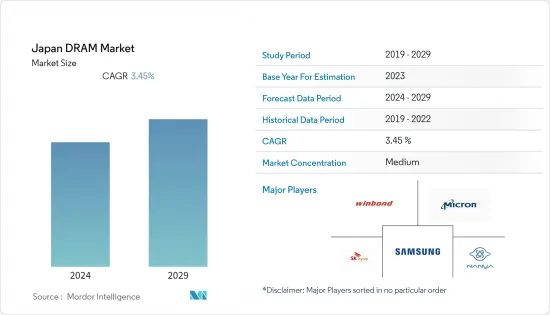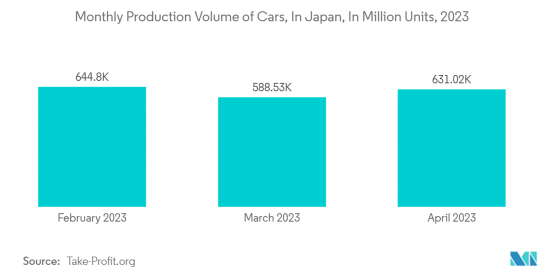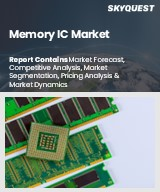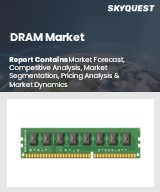
|
시장보고서
상품코드
1408741
일본의 DRAM 시장 : 점유율 분석, 산업 동향 및 통계, 성장 예측(2024-2029년)Japan DRAM - Market Share Analysis, Industry Trends & Statistics, Growth Forecasts 2024 - 2029 |
||||||
일본의 DRAM(디램, Dynamic random access memory) 시장 규모는 33억 5,000만 달러에 달하고, CAGR 3.45%로 추이하며 성장 할 것으로 예상되며, 예측 기간 동안 39억 7,000만 달러에 이를 것으로 예측됩니다.

주요 하이라이트
- 일본에서는 스마트폰, PC, 노트북 PC의 보급이 진행되고 있으며, 기동 시간을 단축하고, 메모리 용량을 늘려 높은 성능을 실현하는 DRAM의 개발이 진행되고 있습니다.
- 일본 스마트폰 보안협회(JSSEC)에 따르면 2022년 7월 국내 휴대전화 월간 출하 대수는 142만대, 2022년 5월에는 68만대였습니다. 또한 5G 지원 스마트폰은 이전 세대에 비해 더 많은 메모리가 필요합니다. 따라서 5G 도입이 진행되는 것은 시장 성장에 기여합니다.
- 카메라 및 태블릿, 센서 및 산업 장비, 의료기기, 자동차 시스템과 같은 소비자 제품은 데이터와 실행 코드를 저장하기 위해 프로세서와 함께 내장된 DRAM 플래시 메모리에 의존합니다. 그러나 데이터센터에서는 읽기/쓰기 요청에 거의 실시간으로 응답하고 데이터 전송 속도가 빠른 DRAM 플래시 메모리가 사용됩니다. DRAM 스토리지의 동향은 인공지능 및 머신러닝 용도을 위한 대규모 데이터 처리에 대한 수요가 증가함에 따라 앞으로도 계속 발전할 가능성이 높습니다.
- 기술의 진보, 인구 증가, 1인당 소득 증가, 고속 인터넷을 용이하게 이용할 수 있게 된 것으로, 국내에서는 스마트폰이나 고도 가전의 보급이 진행되고 있습니다. 따라서 높은 처리 능력과 강화된 메모리 기능을 갖춘 스마트폰, 태블릿, 노트북 등 생산이 증가하고 있어 일본의 DRAM 시장을 촉진할 것으로 예상됩니다.
- 전반적으로 데이터센터와 자동차 부문의 상승은 일본의 DRAM 시장에 대규모 수요를 가져올 것으로 예상됩니다. 소비자 일렉트로닉스 분야 수요는 예측 기간 동안 일정할 것으로 예상됩니다.
- 게임, 자동차, 헬스케어, 통신, 더욱 중요한 것은 5G와 인공지능(AI)과 같은 촉진 요인에서 메모리 요건이 증가함에 따라 각 회사는 새롭고 혁신적인 DRAM 제품에 주력하고 있습니다. 2022년 6월 Micron Technology는 히로시마 공장에서 첨단 DRAM 메모리 칩을 양산할 계획을 발표했습니다. 이 회사는 '1-β'메모리 칩을 일본에서 제조하게 됩니다.
- 또한 Micron은 2022년 11월, 히로시마 공장에서 대용량·고출력의 신형 1-β DRAM 칩의 양산을 개시한다고 발표했습니다. 이 회사는 또한 첨단 칩을 생산하기 위해 일본 정부로부터 3억 2,000만 달러를 받고 있습니다.
일본 DRAM 시장 동향
자동차 부문이 큰 점유율을 차지
- 전기 자동차, SUV, 소형 상용차 수요 증가가 일본의 DRAM 시장 수요를 끌어올릴 것으로 보입니다. 일본 정부는 Honda, Toyota, Suzuki, Mitsubishi, Nissan 등 다양한 국내 브랜드에 의해 지배되고 있습니다.
- 전기 자동차의 보급과 인포테인먼트 시스템의 급속한 발전으로 반도체 자동차 플랫폼은 패러다임 시프트에 직면 해 있습니다. 고화질 지도, 비디오 스트리밍, 3D 게임과 같은 인포테인먼트 시스템의 첨단 기능은 ADAS 수요 급증과 함께 예측 기간 동안 자동차 업계 전체의 대용량 고성능 SSD 그리고 그래픽 DRAM 수요를 크게 견인할 것으로 예상됩니다.
- 일본의 DRAM 시장은 예측 기간 동안 자동차 산업 수요가 높습니다. 수요를 견인하는 주요 요인 중 하나는 5G 인프라를 통합한 자율주행 기술에 대한 관심이 높아지고 있다는 것입니다. 예를 들어, Tesla는 Nvidia의 CPU 및 GPU 솔루션을 채택하여 GDDR5 DRAM 제품의 탑재를 추진했습니다.
- 또한 자동차 산업에서 사물 인터넷(IoT)의 출현은 다목적 용도의 핫스팟으로 뚜렷해지고 있습니다. 커넥티드 자동차에서 자동 운송 시스템에 이르기까지 IoT의 역할은 자동차 시장에서 일본 DRAM 시장에 큰 비즈니스 기회를 가져올 것으로 기대됩니다.
- 여러 자동차 제조업체들이 증가하는 수요에 대응하고 경쟁을 이기기 때문에 일본에서 생산 설비를 확장하고 있습니다. 예를 들어 BYD는 2023년 7월 일본 승용차 시장에 진출한다고 발표했습니다. 이 회사는 Atto 3 모델을 제공합니다. BYD Atto 3는 2023년 1월에 발매 예정입니다. 두 번째 모델은 BYD Dolphin으로 2023년 중반에 출시될 예정이며, 세 번째 모델은 신형 BYD Seal로 2023년 후반에 출시될 예정입니다.
- 또한 자동차공업회가 발표한 데이터에 따르면 2023년도 일본의 자동차 생산 대수는 2023년 2월에 6,31,022대로 증가했습니다. 최대는 9,61,994대, 최소는 2,49,772대입니다. 이러한 자동차 생산량 증가는 일본 자동차 시장에 DRAM의 높은 수요를 가져올 가능성이 높습니다.

데이터센터와 서버 증가가 시장을 촉진
- DRAM은 현대 기업 및 데이터센터용도이 제대로 작동하는 데 필수적인 구성 요소입니다. 클라우드 컴퓨팅, 가상화 및 소프트웨어 정의 서버 기술을 활용하는 데이터센터가 증가함에 따라 정전부터 백업 발전기 시작까지의 시간이 단축되었습니다.
- 사물인터넷 IoT 기술과 빅데이터는 데이터센터에 대한 투자를 증가시켜 일본의 DRAM 시장에 새로운 성장 기회를 더 가져올 것으로 보입니다. 일본 기업은 헬스케어, 은행, 금융서비스, 보험(BFSI), IT 및 통신, 정부 및 방위 등 모든 업계에서 방대한 데이터 생성을 경험하고 있습니다. 클라우드 컴퓨팅의 성장, 외자계 클라우드 프로바이더에 의한 보급 확대, 국내 기업에 의한 투자 확대 등이 시장 성장을 견인하는 주요 요인이 되고 있습니다.
- 새로운 모바일 컴퓨팅 디바이스가 증가함에 따라 다양한 조직에서 데이터센터의 유용성이 증가하고 있습니다. 또한 이 시장에서는 많은 벤더들이 새로운 데이터센터를 설립해 조사 대상 시장을 견인하고 있습니다. 예를 들어 Datadog, Inc.는 2023년 4월 도쿄에 새로운 데이터센터를 개설한다고 발표했습니다. 이 새로운 데이터센터는 현지에서 데이터를 처리 및 저장함으로써 회사와 고객이 현지 데이터 프라이버시 및 보안 규정을 준수할 수 있도록 지원합니다.
- 마찬가지로 2023년 1월 Optage Inc.는 오사카에 새로운 데이터센터를 건설할 계획을 발표했습니다. 이 시설은 히가시우메다 지구에 위치해 있으며, 면적 2,250㎡, 14층 건물입니다.
- 이러한 요구 사항을 충족하기 위해 공급업체는 시장 경쟁력을 유지하는 신제품을 출시합니다. 예를 들어 Samsung Electronics는 2022년 5월 데이터센터 성능을 업그레이드하기 위해 Compute Express Link를 기반으로 DRAM 메모리 기술 개발을 발표했습니다. 이 DDR5는 CXL 인터페이스를 지원하도록 설계되었습니다. CXL 인터페이스는 PCI Express(PCIe) 5.0 인터페이스를 기반으로 하는 개방형 업계 표준 인터커넥트이며 데이터센터에서 프로세서, 호스트, 메모리 버퍼, 가속기, 입출력 장치 등 장치 간 빠르고 낮은 대기 시간 통신을 가능하게 합니다. 하도록 설계되었습니다.
- 또한 일본에서는 정부 주도의 움직임이 활발해지고 있으며, 일본의 DRAM 수요도 비슷한 속도로 증가하고 있습니다. 예를 들어 일본 정부는 2022년 8월 해저케이블의 육상거점을 분산시키고 육상지점을 다양화하는 동시에 전국에 복수의 새로운 데이터센터를 건설할 계획을 발표했습니다. 이를 통해 정부는 지방과 도시 지역의 격차를 줄이고 자연재해와 잠재적인 방해 행위에 대한 내성을 높이는 것을 목표로 하고 있습니다.
일본 DRAM 산업 개요
일본의 DRAM 시장은 다수의 주요 기업들이 시장 점유율 확대를 다투는 완만한 통합이 특징입니다. Samsung Electronics, SKhynix, Winbond 등 유명 기업들이 업계 형성에 있어 매우 중요한 역할을 하고 있습니다. 연구개발에 대한 엄청난 투자를 뒷받침하는 끊임없는 혁신에 대한 헌신은 기업의 경쟁력 확보를 촉진하고 있습니다.
2023년 1월 SK Hynix는 LPDDR5TDRAM을 발표하고 기존 LPDDR5X 기술로부터 현저한 발전을 이루었습니다. 이 혁신적인 LPDDR5T 기술은 인공지능, 스마트폰, 가상현실, 확장 지능, 머신러닝 등 다양한 용도에 적합합니다.
2022년 12월 Samsung Electronics는 16기가비트(Gb) DDR5 DRAM을 발표했습니다. 이 최첨단 DRAM은 업계 최초의 12nm 클래스 공정 기술을 활용하여 제조되었으며, 특히 데이터센터, 차세대 컴퓨팅, AI 구동 시스템 등 운영에서 지속가능성을 향출시키는 데 매우 적합합니다.
2022년 5월, 메모리 및 디지털 스토리지 제품의 유명 제조업체인 Transcend Information, Inc. (Transcend)는 비즈니스 및 퍼스널 컴퓨터용으로 설계된 차세대 DDR5 DRAM 모듈의 제공을 발표했습니다. Transcend의 DDR5 메모리 모듈은 속도, 용량 및 신뢰성에서 JEDEC 표준을 뛰어넘어 메타버스, 고성능 컴퓨팅(HPC), 가상 이코노미 등 용도에서 획기적인 성능을 발휘합니다.
기타 혜택 :
- 엑셀 형식 시장 예측(ME) 시트
- 3개월간 애널리스트 서포트
목차
제1장 서론
- 조사 전제 조건 및 시장 정의
- 조사 범위
제2장 조사 방법
제3장 주요 요약
제4장 시장 인사이트
- 시장 개요
- 산업 가치사슬 분석
- 업계의 매력도-Porter's Five Forces 분석
- 공급기업의 협상력
- 소비자의 협상력
- 신규 참가업체의 위협
- 대체품의 위협
- 경쟁 기업간 경쟁 관계의 강도
- 거시 경제 동향이 시장에 미치는 영향
제5장 시장 역학
- 시장 성장 촉진 요인
- 하이엔드 스마트폰과 소비자용 전자기기의 보급 확대
- 시장 과제
- 원재료와 생산가격 상승
제6장 시장 세분화
- 아키텍처별
- DDR3
- DDR4
- DDR5
- DDR2/기타 아키텍처
- 용도별
- 스마트폰/태블릿
- PC/노트북 PC
- 데이터센터
- 그래픽
- 소비자 제품
- 자동차
- 기타 용도
제7장 경쟁 구도
- 기업 개요
- Samsung Electronics Co. Ltd.
- Micron Technology Inc.
- SKhynix
- Nanya Technology Corporation
- Winbond Electronics Corporation
- Transcend Information
- Kingston Technology
- Infineon Technologies AG
- ATP Electronics
- Elpida Memory Inc.
제8장 투자 분석
제9장 시장의 미래
LYJ 24.01.30
The Japan dynamic random access memory (DRAM) market was valued at USD 3.35 billion in the current year and is expected to register a CAGR of 3.45%, reaching USD 3.97 billion over the forecast period.
Key Highlights
- The growing adoption of smartphones, PCs, and laptops in the country has increased the development of DRAM, which could reduce the boot-up time and enhance the memory space to offer higher performance.
- According to the Japan Smartphone Security Association (JSSEC), the monthly domestic shipment volume of mobile phones in the country was 1.42 million units in July 2022, which was 0.68 million units in May 2022. Further, 5G-enabled smartphones need more memory compared to previous generations. Thus, the increasing implementation of 5G contributes to market growth.
- Consumer products, such as cameras and tablets, sensors and industrial equipment, medical devices, and automotive systems, rely on DRAM flash memory embedded alongside processors to store data and the code they execute. However, data centers use DRAM flash memory for its near real-time response to read/write requests and high data transfer speed. DRAM storage trends are likely to continue to evolve as demand increases for large-scale data processing for artificial intelligence and machine learning applications.
- The advances in technology, increasing population, rise in per capita income, and easy availability of high-speed internet have increased the adoption of smartphones and advanced consumer electronics in the country. Therefore, the growing production of smartphones, tablets, laptops, and others with high processing and enhanced memory capabilities is expected to propel the Japanese dynamic random access memory (DRAM) market.
- Overall, the rising data centers and automotive sectors are expected to create massive demand for the Japanese dynamic random access memory (DRAM) market. The demand from the consumer electronics sector is expected to be constant during the forecast.
- With the increased memory requirements in gaming, automotive, healthcare, telecommunication, and, more importantly, with growth drivers like 5G and artificial intelligence (AI), the companies have been focusing on new and innovative DRAM products. In June 2022, Micron Technology announced its plan to mass-produce advanced DRAM memory chips at its Hiroshima plant. The company would be manufacturing its '1-Beta' Memory Chips in Japan.
- Moreover, in November 2022, Micron announced to start of mass production of its new high-capacity, power 1-beta dynamic random access memory (DRAM) chips at its plant in Hiroshima, Japan. The company has also received USD 320 million from the Japanese government to make advanced chips.
Japan DRAM Market Trends
Automotive Sector Holds Significant Market Share
- The country's growing demand for electric vehicles, SUVs, and light commercial vehicles will boost the demand for Japan's dynamic random access memory (DRAM) market. The government is dominated by various domestic brands such as Honda, Toyota, Suzuki, Mitsubishi, and Nissan.
- The proliferation of electric vehicles and the rapid advancement of infotainment systems are causing the semiconductor automotive platform to face a paradigm shift. Advanced features in infotainment systems like high-definition maps, video streaming, and 3D gaming, coupled with soaring demand for ADAS, are expected to significantly drive the demand for high-capacity, high-performance solid-state drivers (SSDs), and graphics DRAM throughout the automotive industry during the forecast period.
- The Japan dynamic random access memory (DRAM) market has witnessed high demand from the automotive industry during the forecast period. One of the major factors driving the demand is the growing emphasis on autonomous driving technologies with built-in 5G infrastructure. For example, Tesla has adopted Nvidia's CPU and GPU solutions, which drove them to incorporate GDDR5 DRAM products.
- Furthermore, the advent of the Internet of Things (IoT) in the automotive industry has become a prominent hotspot for multi-purpose applications. From connected vehicles to automated transport systems, the role of IoT is expected to open up significant opportunities for the Japan DRAM market in the automotive market.
- Several automobile manufacturers are expanding their production facilities in Japan to meet the growing demand and stay ahead of the competition. For instance, in July 2023, BYD announced it to expand its footprint in Japan's passenger vehicle market. The company will offer the Atto 3 model. BYD Atto 3 is expected to go on sale in January 2023. The second model is the BYD Dolphin, scheduled to be released in mid-2023, and the third model is the all-new BYD Seal, expected to be released in late 2023.
- Moreover, according to data published by the Automobile Manufacturers Association, in FY 2023, in Japan, car Production increased to 6,31,022 Units in February 2023. The maximum volume was 9,61,994 Units, and the minimum was 2,49,772 Units. Such a rise in automobiles is likely to bring the high demand for DRAM in the Japanese automobile market.

Growing Number of Data Centers and Servers Will Boost the Market
- Dynamic random access memory DRAM is an essential component for the proper functioning of modern enterprise and data center applications; the growing data centers in Japan have significantly fueled the demand for the market. An increasing number of data centers utilize cloud computing, virtualization, and software-defined server technology, so the time between power failure and startup of the backup generator has shortened.
- The Internet of Things IoT technology and big data will increase investment in the data center, further creating new growth opportunities for Japan's dynamic random access memory (DRAM) Market. Japanese companies are experiencing massive data generation across all industries, including healthcare, banking, financial services, and insurance (BFSI), IT and telecom, and government & defense. The growth of cloud computing, increased penetration by foreign cloud providers, and increased investments by domestic players are some of the major factors driving the market growth.
- The increase in new mobile computing devices has led to the rise in the utility of data centers among various organizations. Further, many vendors in the market are establishing new data centers, driving the studied market. For instance, In April 2023, Datadog, Inc. announced to launch of its new data center in Tokyo, Japan. This new data center in Japan will help the company and its customers comply with local data privacy and security regulations by processing and storing data locally.
- Similarly, in January 2023, Optage Inc. announced plans to construct a new data center in Osaka, Japan. The facility is located in the Higashi-Umeda district, covers an area of 2,250 square meters, and has 14 floors.
- In order to cater to such requirements, vendors are releasing new products to remain competitive in the market. For instance, in May 2022, Samsung Electronics announced the development of DRAM memory technology based on the Compute Express Link to upgrade the performance of the data centers. The DDR5 is designed to support the CXL interface, which is an open industry-standard interconnect based on the PCI Express (PCIe) 5.0 interface that is designed to enable the data centers with high-speed and low latency communications between the processor, host, and the devices such as memory buffers, accelerators, input and output devices.
- Moreover, with the growing government initiative in the country, the demand for Japanese dynamic random access memory (DRAM) has also been increasing at a similar rate. For instance, in August 2022, the Japanese Government announced plans to build several new data centers across the country along with decentralizing landing bases for submarine cables to diversify landing points. Through this, the Government aims to reduce the disparity between rural and urban areas and provide greater resilience against natural disasters or potential sabotage.
Japan DRAM Industry Overview
The dynamic random access memory (DRAM) market in Japan is characterized by moderate consolidation, with numerous key players vying for an increased market share. Prominent companies such as Samsung Electronics, SK Hynix, and Winbond, among others, play a pivotal role in shaping the industry. Their commitment to incessant innovation, underpinned by substantial investments in research and development, has facilitated their attainment of a competitive edge over their peers.
In January 2023, SK Hynix unveiled its LPDDR5TDRAM, representing a noteworthy advancement over the existing LPDDR5X technology. This innovative LPDDR5T technology is well-suited for diverse applications, including artificial intelligence, smartphones, virtual and augmented reality, and machine learning.
In December 2022, Samsung Electronics Co., Ltd. introduced its 16-gigabit (Gb) DDR5 DRAM. This cutting-edge DRAM is crafted utilizing the industry's first 12nm class process technology, making it highly suitable for enhancing sustainability in operations, especially in data centers, next-generation computing, and AI-driven systems.
In May 2022, Transcend Information, Inc. (Transcend), a renowned manufacturer of memory and digital storage products, announced the availability of its next-generation DDR5 DRAM modules, specifically designed for both business and personal computers. These DDR5 memory modules from Transcend surpass JEDEC standards in terms of speed, capacity, and reliability, ushering in groundbreaking performance in applications such as the metaverse, high-performance computing (HPC), and the virtual economy.
Additional Benefits:
- The market estimate (ME) sheet in Excel format
- 3 months of analyst support
TABLE OF CONTENTS
1 INTRODUCTION
- 1.1 Study Assumptions and Market Definition
- 1.2 Scope of the Study
2 RESEARCH METHODOLOGY
3 EXECUTIVE SUMMARY
4 MARKET INSIGHTS
- 4.1 Market Overview
- 4.2 Industry Value Chain Analysis
- 4.3 Industry Attractiveness - Porter's Five Forces Analysis
- 4.3.1 Bargaining Power of Suppliers
- 4.3.2 Bargaining Power of Consumers
- 4.3.3 Threat of New Entrants
- 4.3.4 Threat of Substitute Products
- 4.3.5 Intensity of Competitive Rivalry
- 4.4 Impact of Macroeconomic Trends on the Market
5 MARKET DYNAMICS
- 5.1 Market Drivers
- 5.1.1 Growing Adoption of High-End Smartphones and Consumer Electronics
- 5.2 Market Challenges
- 5.2.1 Rising Raw Material and Production Prices
6 MARKET SEGMENTATION
- 6.1 By Architecture
- 6.1.1 DDR3
- 6.1.2 DDR4
- 6.1.3 DDR5
- 6.1.4 DDR2/Other Architecture
- 6.2 By Application
- 6.2.1 Smartphones/Tablets
- 6.2.2 PC/Laptop
- 6.2.3 Datacenter
- 6.2.4 Graphics
- 6.2.5 Consumer Products
- 6.2.6 Automotive
- 6.2.7 Other Applications
7 COMPETITIVE LANDSCAPE
- 7.1 Company Profiles
- 7.1.1 Samsung Electronics Co. Ltd.
- 7.1.2 Micron Technology Inc.
- 7.1.3 SK Hynix
- 7.1.4 Nanya Technology Corporation
- 7.1.5 Winbond Electronics Corporation
- 7.1.6 Transcend Information
- 7.1.7 Kingston Technology
- 7.1.8 Infineon Technologies AG
- 7.1.9 ATP Electronics
- 7.1.10 Elpida Memory Inc.



















